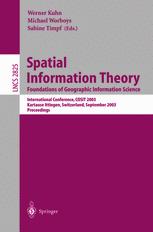

Most ebook files are in PDF format, so you can easily read them using various software such as Foxit Reader or directly on the Google Chrome browser.
Some ebook files are released by publishers in other formats such as .awz, .mobi, .epub, .fb2, etc. You may need to install specific software to read these formats on mobile/PC, such as Calibre.
Please read the tutorial at this link: https://ebookbell.com/faq
We offer FREE conversion to the popular formats you request; however, this may take some time. Therefore, right after payment, please email us, and we will try to provide the service as quickly as possible.
For some exceptional file formats or broken links (if any), please refrain from opening any disputes. Instead, email us first, and we will try to assist within a maximum of 6 hours.
EbookBell Team

5.0
38 reviewsCOSIT,theseriesofConferencesonSpatialInformationTheory,hasbeenaround for more than ten years. Its hallmarks are a fruitful interdisciplinary dialogue between computational and human perspectives on spatio-temporal information and a thorough review process that selects the best papers while giving all - thors detailed feedback on how to develop their work. A clear pro?le of the COSIT community has emerged from the series of conference proceedings, all published as Springer Lecture Notes in Computer Science, and from the per- nent web site at http://www. cosit. info, containing links to the conference web sites and proceedings, a history and program of the series, an impact study, interviews with participants, and pictures. The proceedings of this sixth conference provide ample evidence that COSIT is healthy and maturing, while retaining its youth. Out of the 61 submissions, the program committee selected 26 papers for presentation, in discussions based on at least three double-blind reviews and one or more meta-review from PC members for each paper. Classical COSIT themes, such as spatial reasoning (about distances and directions, regions and shapes) or vagueness are being f- ther re?ned; topics like way?nding and landmarks are boosted by new synergies betweencognitiveandcomputationalapproaches;andthestudyofontologiesfor space and time, a subject since the ?rst COSIT, is gaining more depth.